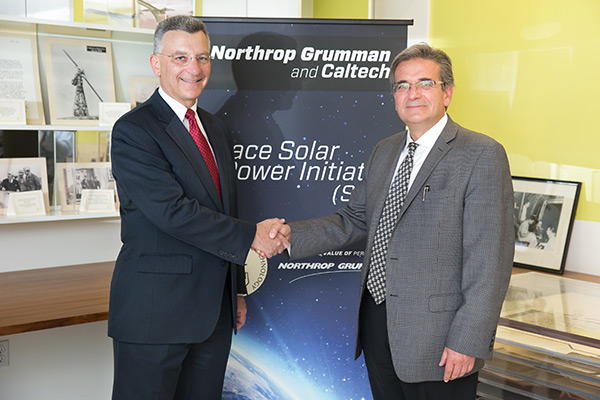PASADENA, Calif. – April 20, 2015 – Northrop Grumman Corporation (NYSE:NOC) has signed a sponsored research agreement with the California Institute of Technology (Caltech) for the development of the Space Solar Power Initiative (SSPI). Under the terms of the agreement, Northrop Grumman will provide up to $17.5 million to the initiative over three years.
Working together, the team will develop the scientific and technological innovations necessary to enable a space-based solar power system capable of generating electric power at cost parity with grid-connected fossil fuel power plants. SSPI responds to the engineering challenge of providing a cost-competitive source of sustainable energy. SSPI will develop technologies in three areas: high-efficiency ultralight photovoltaics; ultralight deployable space structures; and phased array and power transmission.

SSPI was conceived by three principal investigators from Caltech’s Division of Engineering and Applied Science (EAS) who jointly lead the initiative:
- Harry A. Atwater, Jr., Howard Hughes Professor of Applied Physics and Materials Science, Director of the Resnick Sustainability Institute;
- Ali Hajimiri, Thomas G. Myers Professor of Electrical Engineering and Medical Engineering; and
- Sergio Pellegrino, Joyce and Kent Kresa Professor of Aeronautics, Professor of Civil Engineering and Jet Propulsion Laboratory Senior Research Scientist.
Atwater, Hajimiri and Pellegrino have assembled a team of students, postdoctoral scholars, and senior researchers that will eventually exceed 50 members. EAS is building specialized laboratory facilities to support this team. Northrop Grumman engineers and scientists will collaborate with the team at Caltech to develop solutions, build prototypes and obtain experimental and numerical validation of concepts that could allow development to proceed toward eventual implementation.
“By working together with Caltech, Northrop Grumman extends its long heritage of innovation in space-based technologies and mission solutions,” said Joseph Ensor, vice president and general manager, Space Intelligence, Surveillance and Reconnaissance (ISR) Systems, Northrop Grumman. “The potential breakthroughs from this research could have extensive applications across a number of related power use challenges.”
“This initiative is a great example of how Caltech engineers are working at the leading edges of fundamental science to invent the technologies of the future,” said Ares Rosakis, Otis Booth Leadership Chair of the Caltech Division of Engineering and Applied Science and the Theodore von Kármán Professor of Aeronautics and Professor of Mechanical Engineering. “The Space Solar Power Initiative brings together electrical engineers, applied physicists, and aerospace engineers in the type of profound interdisciplinary collaboration that is seamlessly enhanced at a small place like Caltech. I believe it also demonstrates the value of industry and academic partnerships. We are working on extremely difficult problems that could eventually provide the foundations for new industries.”
Caltech and Northrop Grumman have a long history of collaboration, dating back decades to joint work between Professor Theodore von Kármán and Jack Northrop. Von Kármán was a scientist and engineer who directed Caltech’s Guggenheim Aeronautical Laboratory during the 1930s and later co-founded the Jet Propulsion Laboratory. Northrop was an aviation pioneer who in 1939 founded the Northrop Corporation, one of the legacy companies that united to become Northrop Grumman. This unique $17.5 million initiative is one of the largest corporate sponsored research projects Caltech has undertaken in recent years.



















1 thought on “Northrop Grumman and Caltech begin Space Solar Power Initiative”
Technology like this robotic assembly and build in space could significantly forward the space based solar power effort.. Telerobotic equipment in LEO could be particularly useful as well.. Operators on the ground could have real time control over assembly tools in LEO this provides the dynamic resourcefulness of the human worker and reduces the complexity of the robotics.. Less complex and costly robotic tools yet more adaptable and efficient by incorporating the human minds controlling the equipment from the comfort of the surface of the Earth..
https://www.facebook.com/FollowNASA360/videos/10155479987520285/?pnref=story
This technology will greatly increase the transmission efficiency of beamed electrical power.. This is a big step forward for space based solar power..
http://www.spacedaily.com/reports/Harvesting_energy_from_electromagnetic_waves_999.html
The ESA – European Space Agency’s research in Telerobotics is key to paving the way to an ambitious space exploration agenda.. Telerobotics will give astronaut explorers the ability to so much more… Astronauts could operate these robotic systems to do a myriad of tasks from a distant location or even from orbit.. Operating robotic systems on the surface of distant worlds from orbit is a much less expensive, simpler and safer way of exploration.. Telerobotics will without a doubt find many other uses in various industries where there value will be proven…
http://www.esa.int/spaceinvideos/Videos/2015/03/ESA_Telerobotics_Part_1_-_Haptics
ESA’s Telerobotics and Haptics Lab
The ESA Telerobotics & Haptics Laboratory is an engineering research laboratory that performs fundamental research in the domains of telerobotics, mechatronics, haptics and human-robot interaction. The Laboratory output is targeted at supporting novel spaceflight projects by pre-development and demonstration of critical technologies.
http://esa-telerobotics.net/
To achieve our space exploration goals we need to deal with two major problems.. The effects of 0 G on the human body and the effects of radiation on the human body..
We need a large spacecraft to facilitate artificial gravity and some form of radiation mitigation.. Modular in construction for easy adaptability for different missions with different objectives.. Transporting astronauts up and down from the Earth’s surface using any of the existing spacecraft to a larger craft that stays in space.. The same construction methods and resupply methods we currently employ for missions on the International Space Station.. A streamlining and standardization of space hardware manufacturing could make for more cost effective space exploration and science.. The same components used to construct a space vessel and orbiting platforms above the Earth, the Moon, Mars, Venus, Europa etc…Streamlined manufacturing systems have furthered nearly every industry in history.. Why not spaceflight?.. Practical solutions with long term policy commitments will make a progressive path to a better future.. Remember… Every dollar invested in space exploration returns more than 12 to the economy..
http://www.scribd.com/doc/51592987/Nautilus-X-Holderman-1-26-11